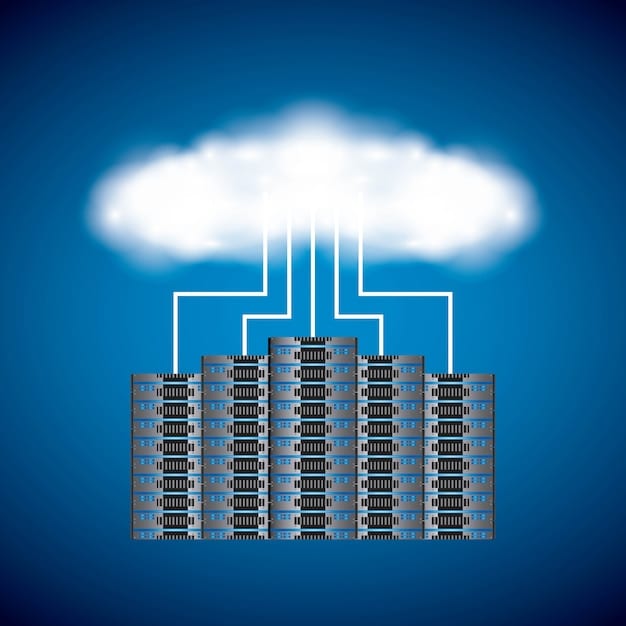Cloud Computing in the US: Evolution, Trends & Future Predictions

The Evolution of Cloud Computing: Trends and Predictions for the US Market reveals how cloud services have transformed U.S. businesses and outlines the expected future trends, including AI integration, edge computing, and enhanced security measures impacting market growth.
The digital landscape in the United States is constantly evolving, and at the heart of this transformation lies cloud computing. Let’s explore The Evolution of Cloud Computing: Trends and Predictions for the US Market, examining how it has reshaped businesses and what the future holds.
The Cloud’s Inception in the US Market
Cloud computing has revolutionized the way businesses operate, offering scalability and cost-efficiency. Understanding its origins helps contextualize its current and future impact on the US market.
Early Stages of Cloud Adoption
Initially, cloud computing was met with skepticism. However, early adopters soon recognized its potential to reduce IT infrastructure costs and improve operational efficiency.
Key Milestones in Cloud Development
Several milestones mark the evolution of cloud computing, including the introduction of virtualization technology and the launch of Amazon Web Services (AWS) in 2006, which significantly lowered the barrier to entry for businesses.
- Virtualization Technology: Facilitated the creation of multiple virtual instances on a single physical server, enhancing resource utilization.
- AWS Launch: Provided on-demand cloud services, transforming the IT landscape and enabling startups to compete with larger companies.
- Open Source Contributions: The rise of open-source cloud platforms like OpenStack promoted innovation and customization.
These early developments set the stage for the widespread adoption of cloud computing across various industries, driving innovation and creating new business models.
Current Cloud Computing Trends in the US
The US cloud computing market is dynamic, with several trends shaping its trajectory. These trends include advancements in AI, edge computing, and cybersecurity.
Artificial Intelligence (AI) and Machine Learning (ML) Integration
AI and ML are increasingly integrated into cloud services, providing businesses with advanced analytics and automation capabilities.
Edge Computing
Edge computing brings computation and data storage closer to the source, reducing latency and improving performance for applications like IoT and autonomous vehicles.

The integration of AI and edge computing are driving significant improvements in operational efficiency and creating new possibilities for businesses in the US.
Cloud Security Enhancements
As cloud adoption increases, security remains a top priority. Advancements in encryption, identity management, and threat detection are crucial.
Encryption and Data Protection
Advanced encryption methods ensure data is protected both in transit and at rest, reducing the risk of data breaches. Compliance with regulations like GDPR further strengthens data protection measures.
Identity and Access Management (IAM)
IAM systems provide granular control over who can access specific cloud resources, minimizing the risk of unauthorized access. Multi-factor authentication (MFA) adds an additional layer of security.
- Advanced Encryption: Protects sensitive data from unauthorized access.
- Multi-Factor Authentication (MFA): Adds an extra layer of security by requiring multiple verification methods.
- Threat Detection Systems: Utilize AI to identify and respond to potential security threats in real-time.
Enhanced security measures provide businesses with the confidence to migrate more sensitive workloads to the cloud, fostering further innovation and growth in the US market.
Predictions for the Future of Cloud Computing in the US
Looking ahead, several key trends are expected to shape the future of cloud computing in the US. These include serverless computing, hybrid cloud solutions, and sustainability initiatives.
Serverless Computing
Serverless computing allows developers to focus on writing code without managing servers, reducing operational overhead and improving scalability.
Hybrid Cloud Solutions
Hybrid cloud solutions combine on-premises infrastructure with public cloud services, providing businesses with flexibility and control over their IT resources.

These emerging trends are poised to further transform the landscape of cloud computing, offering businesses new avenues for innovation and efficiency.
The Rise of Specialized Cloud Services
As the cloud market matures, specialized cloud services tailored to specific industries are gaining traction. These services address the unique needs and requirements of various sectors.
Healthcare Cloud Solutions
Healthcare cloud solutions ensure compliance with HIPAA regulations while providing secure data storage and analytics capabilities.
Financial Services Cloud Solutions
Financial services cloud solutions offer secure platforms for trading, risk management, and customer relationship management (CRM), complying with stringent regulatory requirements.
The increasing availability of specialized cloud services empowers businesses to leverage the cloud in a more tailored and effective manner, driving innovation and competitive advantage.
Challenges and Opportunities in the US Cloud Market
Despite its numerous benefits, cloud computing also presents challenges. Addressing these challenges is crucial for unlocking the full potential of the US cloud market.
Data Security and Compliance
Ensuring data security and compliance with regulations like HIPAA and GDPR remains a significant challenge. Businesses must invest in robust security measures and compliance frameworks.
Skills Gap
A shortage of skilled cloud professionals hinders adoption. Training and education programs are needed to bridge the skills gap and support continued growth.
- Enhanced Training Programs: Investing in comprehensive training programs to develop cloud skills.
- Robust Security Measures: Implementing advanced security protocols to protect against data breaches.
- Clear Compliance Frameworks: Establishing clear guidelines and frameworks to ensure regulatory compliance.
Overcoming these challenges will pave the way for continued growth and innovation in the US cloud market, allowing businesses to fully leverage the benefits of cloud computing.
| Key Point | Brief Description |
|---|---|
| 🚀 Cloud Evolution | From virtualization to AWS, pivotal moments shaped the cloud. |
| 💡 AI & ML | Integration drives advanced analytics and automation. |
| 🔒 Security | Encryption and IAM enhance data protection. |
| 🌿 Sustainability | Green cloud initiatives are vital for environmental responsibility. |
Frequently Asked Questions
▼
Cloud computing involves delivering computing services—including servers, storage, databases, networking, software, analytics, and intelligence—over the Internet (“the cloud”) to offer faster innovation, flexible resources, and economies of scale.
▼
Cloud security is robust, featuring encryption, IAM, and MFA. Providers invest heavily in security infrastructure, often surpassing what individual businesses can afford, making cloud environments generally very secure.
▼
Hybrid cloud solutions combine on-premises infrastructure with public cloud services, providing businesses with flexibility and control. This setup allows for optimized resource allocation and workload management across different environments.
▼
AI is integrated into cloud services for advanced analytics, automation, and threat detection. It enhances operational efficiency and provides insights that drive better decision-making, improving overall business performance.
▼
Edge computing reduces latency and improves performance by bringing computation closer to the data source. This is vital for applications like IoT and autonomous vehicles, ensuring real-time processing and enhanced user experiences.
Conclusion
As the evolution of cloud computing continues its trajectory in the US market, businesses that embrace these trends and address the associated challenges will be best positioned to thrive in the digital age. The future of cloud computing promises greater efficiency, innovation, and competitive advantage for those ready to adapt and invest strategically.





